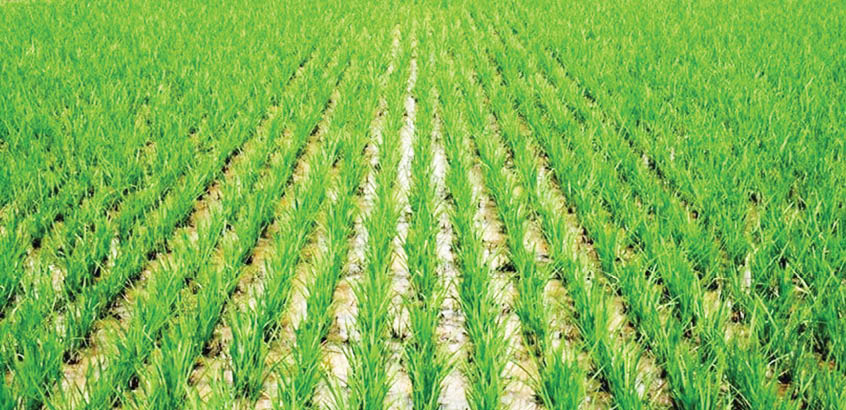Greening Abuja with food
The ongoing civil unrest calling on the government to urgently find a lasting solution to the prevailing skyrocketing cost of food is a pointer that we must be on our toes to provide a sustainable solution for easing the hard living condition in the land. The promotion of urban aesthetics with ornamental plant species used […]

FILE PHOTO: A rice farm
The ongoing civil unrest calling on the government to urgently find a lasting solution to the prevailing skyrocketing cost of food is a pointer that we must be on our toes to provide a sustainable solution for easing the hard living condition in the land.
The promotion of urban aesthetics with ornamental plant species used to be advocated for the beautification of our urban centres, preservation of the plant species and ensuring balance of the ecosystem. Similar goals can be achieved with a very little difference when cities are adorned by cultivation. The additional benefit is the alleviation of the food security challenge.
This approach has already been adopted in one of the African countries that experienced one of the worst civil unrests in recent history. The cultivated lands adorning the valleys within and surrounding Kigali, the Rwandan capital city, are always clearly visible from the sky while about to land at the Kigali International Airport. Urban agriculture has become the norm in urban land uses rather than the exception, and is gaining greater acceptance throughout the world. It is known from various literatures that urban farming, apart from protecting the environment, reduces the need to bring in food. About 800 million urban and peri-urban farmers produce 15 per cent of world food.
Until the mid-1990s when massive population growth and rising demand overwhelmed local food supplies, urban farmers in China’s 18 largest cities were able to produce 90 per cent of the locally consumed vegetables and half the meat and poultry. Hong Kong produces two-thirds of the poultry, half the vegetables and 40 per cent of the fish it consumes. Singapore is completely urbanised and produces all its meat and fish and one-quarter of its vegetables (UNDP 1996; O’meara 1999 and population reports 2001).
- Residents protest kidnapping, block Kaduna-Abuja highway
- FCTA launches free delivery kits for pregnant health insurance enrollees
Abuja is located within the Guinea Savanna region, suitable for the growth of both forest and crop land plant species, thus by implication it offers one of the best agricultural lands for the food production of the entire country. The preferred choice for siting the city where it now occupies is the Gwagwa plains. It offers undulating terrain considered best for urban development, and could accommodate the marriage between agriculture and urban development.
The Abuja master plan envisages limited scope of agricultural development in urban area and informal sector agriculture activities, like sericulture, horticulture, and floriculture and honey production, as against large-scale agriculture and crop production as currently practised in the rural areas and the surrounding states. By implication, food is to be imported from the neighbouring states to feed the FCT population.
In recent past, there was a remarkable movement of skilled artisans in the irrigation and other informal agriculture, leading to the exploitation of the resources of the valleys between Hilton and former Sheraton hotels, to Durumi and other streams and valleys for incremental crop production, gardens, horticulture, etc. The policy of allocating these green areas to organisations for development of parks and recreations drove out the artisans. In most of the lands allocated for the parks, with the exception of the likes of Millennium Park and Wonderland and other very few, there are very few desired developments. Contrarily, most of these areas now serve as hiding places for miscreants.
Due to the present challenges of rapid population growth in cities, coupled with the soaring cost of food items and increasing food insecurity, it has become necessary to accommodate agricultural activities within urban areas at least to augment the food requirements of the increased population. All these vast arable lands could be devoted to green development, a modelled, controlled and systematic agriculture that shall ensure multiple benefits in terms of food production for urban sustenance, improved aesthetics, additional employment and environmental protection.
In some areas, especially around the stream valleys, where soft landscaping is required instead of allowing only low grasses that could over-grow in the absence of maintenance, with no economic value, a mixture of vegetables and flowers could be grown by irrigation. Where hard landscaping is required, orchids for tree crops such as oranges, guavas, cashews, mangoes and others could be introduced.This will serve as another takeaway for mitigating desertification
It is important to note that the ecological location of FCT offers a unique stage for the cultivation of assorted crops and landscaping, agro-forestry and leaves ample scope for fisheries, wildlife and other recreational activities. More so, the stream valleys suitable for urban agriculture still exist and are unutilised. If committed for other forms of green area development, it is suggested for it to be reviewed. For those not yet committed, these advantages need to be explored.
Not long ago the presidency sent a circular to states, federal ministries and agencies to evolve ways of improvement of food security in the country. We further suggest that the FCTA subject stream valleys and other suitable green areas within and surrounding the city, and even to the satellite towns, to agronomic test and valuation for suitability of urban agriculture with the most suitable species and make a deliberate policy for its encouragement.
